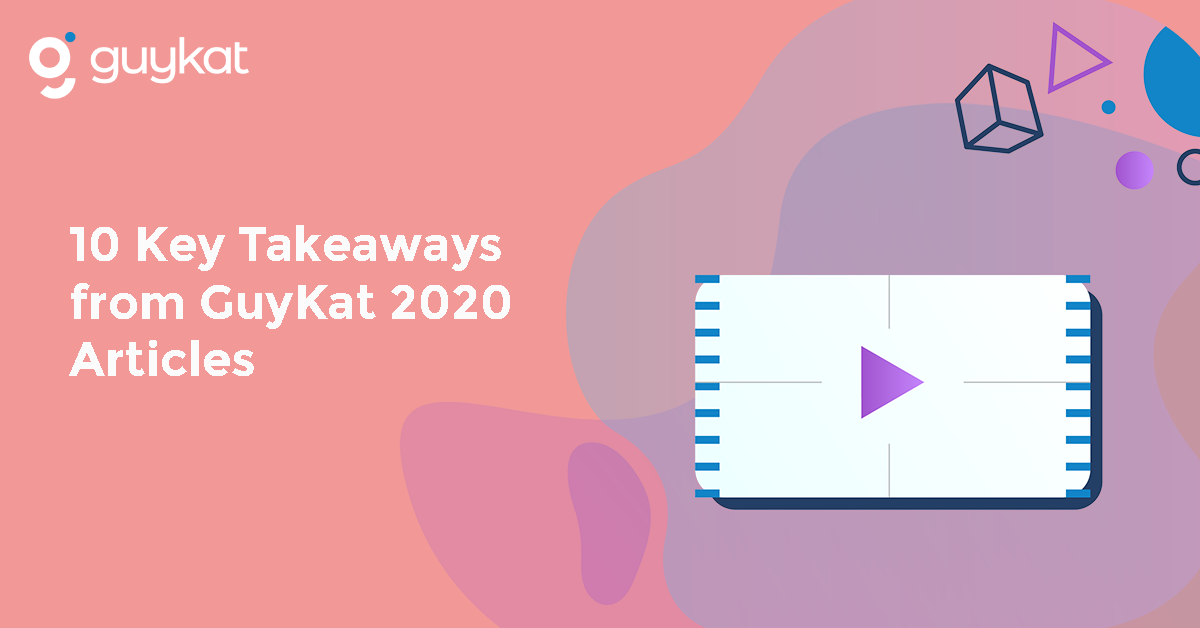We’ve shared a ton of content via articles in 2020. We thought it would make a nice end to the year to summarise 10 Key takeaways from the thousands of words written!
Content is as important as the platform
Unfortunately, many professionals place a higher priority on their learning plan compared to content. It’s indisputable that the look and feel, flow and execution of the platform is key for the success of Learning and Development – however, this should not be the sole focus of your effort. eLearning content plays a vital role in your learning strategy. Even if your platform is the best on the market – if you’re using it to present poor eLearning content to your learners it’s unlikely to achieve the desired effect and have a positive learning impact. Both parts, content and platform, are important and you can’t do one successfully without the other.
Related content: How to motivate a sceptical learner
Pilot projects spare pain
Test the water of new features, functions and systems with a small pilot project first. This is a low-risk way to get feedback and refine ahead of any larger rollouts. Also, a strong proven approach (or ‘template’) will help establish a clear process for future projects.
Related content: The ultimate checklist for a successful multi-country rollout
Documentation matters
Keep an offline document of the configuration and decisions made during the original project for easy reference. Additionally, set-up a monthly or quarterly forum to gather feedback from your learners and identify if there are patterns in requests e.g perhaps there’s a desire to expand the social area of your platform, or rollout Gamification.
Related content: Are you getting the most of your Learning Platform?
Be mindful of your learning objectives
One key thing we tell our clients is to always include learning objectives. Sometimes learning objectives are explicitly referenced in the content e.g. you may have a screen that tells the learner “By the end of the module you will be able to explain the procurement process”. Sometimes, you may not want to be so explicit to the learner. Either way, you need to make sure that every part of the storyboard is supporting the delivery of a learning objective. Make the goals of the training clear upfront and ensure they are achieved by the end of the training. You could implement a function that allows the user to tick off objectives as they are completed to help them feel a sense of progress.
Related content: 5 steps to a successful eLearning project
Adapt your approach to your audience
Different audiences require different approaches. Just as TV shows and movies are made to target certain demographics, we need to do the same with our eLearning to ensure the information is transferred to the user in the most effective way. One of the most important questions we ask our clients before we begin development is ‘Who is this training for?’. We need to know who we are aiming the content at; the age range of the learners, their pre-existing knowledge of the topic in question, if they have taken a course like this before and so on. Knowing this information can drastically change how we design and develop our content and affects everything from the look and feel of the course to how long it takes to complete.
Related content: Tailoring your learning content to your audience
Use branding that’s authentic
Authentic look and feel encourage learners to interact with training materials, as it provides them with a sense of professionalism and motivation. You never get a second chance to make a first impression. The first experience a user has of your platform is the landing page. Putting effort into making the landing page clear and intuitive will change how users ‘feel’ about logging on to the platform. A mistake we often see is overwhelming the user with too many options, content and information. Keep it simple, clean and sign-post what to do next.
Related content: 5 easy ways to improve your Learning Platform’s UX
Related content: How building a custom landing page enhances your UX
Content that’s organised in Netflix Style is the way to go
The initial one catalogue concept used to be the norm, where you show categories to the end-user and let them filter their catalogue based on those categories. However, this is not something being heavily used nowadays. We’ve seen the shift to have more, and smaller catalogues. This represents the style of modern websites such as Netflix and Youtube on the catalogue page that seems to be working well. Instead of having one massive catalogue that people have to struggle to find things, bite-size catalogues, that are auto-filtered to the end-user seems to work effectively. User-experience at it’s finest – it’s like you’re browsing your favourite Netflix genres.
Related content: Organise Content to Increase Learning Engagement
Analyse your learner’s behaviour (eLearning modules)
Keep track of user results and metrics, such as how long they spent taking the course, if they paused it and at what point if a particular question received a low average score and so on. This could clarify issues with the training and help you pinpoint where users may have lost interest or struggled.
Related content: Tailoring your learning content to your audience
Have a clear strategy if adopting user-generated content
Require expert review before content can be published. Having this setting enabled means that you can allow learners the option to contribute content, however, Admins will need to review it and consciously make a decision to approve or reject it.
Related content: User-generated content: Why is it important and how to use it effectively
Lead by example to motivate your learners
If you are the Head of Learning or Account Executive with a passion for learning – communicate that with others. Nothing compares to human communication. Be vocal about how much you love learning, why you think it’s important for you and the company and others will follow. Become an ambassador for those who need a little bit of a push and you’ll see how quickly the motivation grows.
Related content: How to motivate a sceptical learner


